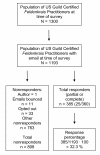A preliminary survey of the practice patterns of United States Guild Certified Feldenkrais PractitionersCM
- PMID: 20359346
- PMCID: PMC2858091
- DOI: 10.1186/1472-6882-10-12
A preliminary survey of the practice patterns of United States Guild Certified Feldenkrais PractitionersCM
Abstract
Background: The Feldenkrais Method(R) of somatic education purports to guide people of varying ages and abilities to improve function. Many people choose this method to aid with recovery from injury, manage chronic conditions, or enhance performance even though limited research supporting its safety and effectiveness exists to guide decisions about use and referral. Very little information about practitioner characteristics and practice patterns is publicly available to assist researchers in the design of appropriate safety and effectiveness studies. The purpose of this study was to obtain an initial overview of the characteristics of United States Guild Certified Feldenkrais PractitionersCM.
Methods: Of 1300 certified Feldenkrais practitioners at the time of the study, there were 1193 practitioners with email accounts who were sent invitations to complete a web-based survey. The survey inquired about practice locations, additional credentials, service patterns and workloads during the previous 3 months. Response rate and descriptive statistics were calculated.
Results: The survey had a 32.3% (385/1193) response rate. The top states in which responders practiced were California (n = 92) and New York (n = 44). Most responders did not hold other credentials as traditional health care providers or as complementary and alternative medicine providers. Among those who did, the most common credentials were physical therapist (n = 83) and massage therapist (n = 38). Just over a third of traditional health care providers only provided Feldenkrais lessons, compared to 59.3% of complementary and alternative providers. On average, responders saw 7.6 +/- 8.1 (median = 5) clients per week for individual lessons, 8.4 +/- 11.5 (median = 5) clients per week for group lessons, and 2.9 +/- 3.9 (median = 2) new clients per month for individual lessons.
Conclusions: This preliminary survey of United States Guild Certified Feldenkrais Practitioners indicated that most practiced in the west and northeast, did not hold additional credentials, and had part-time practices. Those who were traditional health care providers were more likely than complementary and alternative medicine providers in other areas to combine their services. These results provide a foundation for further analyses of Feldenkrais practitioner characteristics and practice patterns that can aid the design of safety and effectiveness studies, and enhance use and referral decision-making.
Figures
Similar articles
-
United States Guild Certified Feldenkrais Teachers®: a survey of characteristics and practice patterns.BMC Complement Altern Med. 2014 Jul 2;14:217. doi: 10.1186/1472-6882-14-217. BMC Complement Altern Med. 2014. PMID: 24985488 Free PMC article.
-
Dental screening and referral of young children by pediatric primary care providers.Pediatrics. 2004 Nov;114(5):e642-52. doi: 10.1542/peds.2004-1269. Pediatrics. 2004. PMID: 15520094
-
The 2017 Diabetes Educator and the Diabetes Self-Management Education National Practice Survey.Diabetes Educ. 2018 Jun;44(3):260-268. doi: 10.1177/0145721718765446. Epub 2018 Mar 28. Diabetes Educ. 2018. PMID: 29589821
-
United States family planning providers' knowledge of and attitudes towards preexposure prophylaxis for HIV prevention: a national survey.Contraception. 2016 May;93(5):463-9. doi: 10.1016/j.contraception.2015.12.018. Epub 2016 Jan 6. Contraception. 2016. PMID: 26772906
-
U.S. Physician Recommendations to Their Patients About the Use of Complementary Health Approaches.J Altern Complement Med. 2020 Jan;26(1):25-33. doi: 10.1089/acm.2019.0303. Epub 2019 Dec 2. J Altern Complement Med. 2020. PMID: 31763927 Free PMC article.
Cited by
-
Manipulative therapy (Feldenkrais, massage, chiropractic manipulation) for neck pain.Curr Rheumatol Rep. 2013 Jul;15(7):339. doi: 10.1007/s11926-013-0339-x. Curr Rheumatol Rep. 2013. PMID: 23666468 Review.
-
Dance Intervention Using the Feldenkrais Method Improves Motor, and Non-Motor Symptoms and Gait in Parkinson's Disease: A 12-Month Study.J Mov Disord. 2022 Jan;15(1):53-57. doi: 10.14802/jmd.21086. Epub 2021 Nov 3. J Mov Disord. 2022. PMID: 34724780 Free PMC article.
-
Feldenkrais 'Functional Integration' Increases Body Contact Surface in the Supine Position: A Randomized-Controlled Experimental Study.Front Psychol. 2018 Oct 24;9:2023. doi: 10.3389/fpsyg.2018.02023. eCollection 2018. Front Psychol. 2018. PMID: 30405500 Free PMC article.
-
United States Guild Certified Feldenkrais Teachers®: a survey of characteristics and practice patterns.BMC Complement Altern Med. 2014 Jul 2;14:217. doi: 10.1186/1472-6882-14-217. BMC Complement Altern Med. 2014. PMID: 24985488 Free PMC article.
References
-
- Buchanan P, Ulrich B. The Feldenkrais Method: a dynamic approach to changing motor behavior. Res Q Exerc Sport. 2001;72:315–323. - PubMed
-
- Feldenkrais M. Awareness Through Movement: Health Exercises for Personal Growth. New York: Harper and Row; 1972.
-
- Barnes PM, Bloom B, Nahin RL. Complementary and Alternative Medicine Use Among Adults and Children: United States, 2007. Natl Health Stat Report. 2008;12:1–24. - PubMed
-
- National Center for Complementary and Alternative Medicine. http://www.fvpt.com/manipulative.pdf
-
- The Feldenkrais Method of Somatic Education. http://www.feldenkrais.com/method/a_biography_of_moshe_feldenkrais/
MeSH terms
LinkOut - more resources
Full Text Sources
Medical


